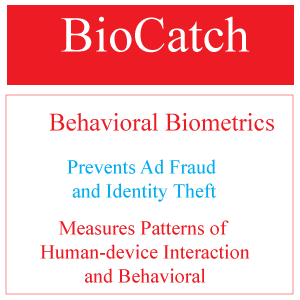BioCatch recently announced its next-gen behavioral biometrics platform, which has been developed for use with online and mobile applications for enterprises. Behavioral biometrics is a burgeoning field of study given the growing threat of online fraud and identity theft. Rather than relying on fingerprints and other physical attributes to confirm identity, behavioral biometric systems do so by measuring patterns of human-device interaction and behavior (e.g. gait, handwriting, typing style, etc.).
The advantage that behavioral biometric security has over other forms of cybersecurity is that it can identify malicious agents even after they successfully breach an account, by monitoring and analyzing their activities and behavioral patterns.
BioCatch has established itself as a leader in the budding field of behavioral biometrics due to its portfolio of patents. Earlier this year, it was granted its fourth patent by the US Patent Office, entitled “ Device, system, and method for detecting user identity based on motor control loop model.” The patent covers the method through which BioCatch’s platform extracts cognitive parameters from the interaction between a user and a device, allowing for continuous user authentication. The method measures cognitive motor, behavioral, physiological, and/or anatomical parameters, covering everything including hand tremors, hand-eye coordination, usage preferences and device interaction patterns. This information, combined with contextual data such as device ID and geolocation create a comprehensive and accurate user profile that is difficult to imitate.
Overall, the goal is to “passively and seamlessly distinguish a legitimate user from an imposter, providing information in real-time while preventing false alerts” said Eyal Goldwerger, BioCatch Chief Executive Officer.
The new platform, dubbed BioCatch 2.0, continuously collects data along a set of behavioral parameters in order to identify a wide variety of Trojans, bots, aggregators, and other forms of malware, and distinguish them from legitimate users. That data is collected not only within pages, but between pages, both online and on mobile. Because BioCatch data capture works with a light JavaScript code, it doesn’t impede web browsing and page loading.
BioCatch 2.0 logs failed login attempts to track bots and criminals trying to break into an account. It also comes with real-time behavioral analysis, quickly calculates risk-scores in less than 500 milliseconds, and features a graphical analytics interface for use by fraud teams.
The major improvement that the next-gen platform brings is the expanded range and richness of behavioral data collection. In order to implement the solution, enterprise clients simply need to add a piece of code to their mobile app or website, which then starts transmitting the behavioral data to the BioCatch system.

